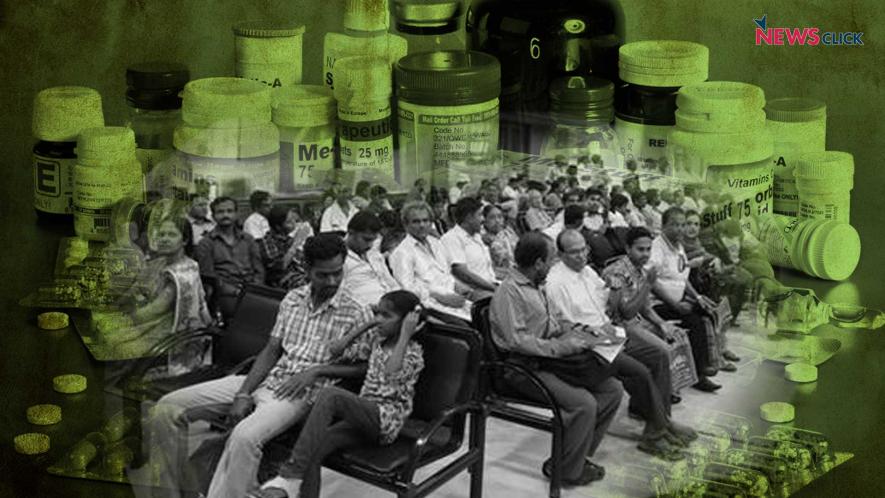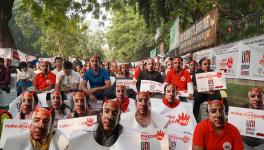Draft Pharmaceutical Policy: Directionless and Inadequate

Newsclick Image by Nitesh Kumar
The Department of Pharmaceuticals (DoP) has recently circulated a draft Pharmaceutical Policy. The broad ambitions outlined in the policy are unexceptionable, and include:
-
Making essential drugs accessible at affordable prices to the common masses;
-
Providing a longer term stable policy environment for the pharmaceutical sector;
-
Making India sufficiently self-reliant in end to end indigenous drug manufacturing;
-
Ensuring world class quality of drugs for domestic consumption & exports;
-
Creating an environment for R&D to produce innovator drugs.
However the sketchy proposals in the policy fail to provide directions as regards how these objectives shall be met. Provided below is a brief analysis of the major issues outlined in the draft.
Incentivizing Manufacturing of Medicines from Basic Stage
The policy recognizes, at least partially, that the pharmaceutical sector faces a looming crisis and acknowledges that compound annual growth has slowed down from 14.36% in 2010-11 to 8.68% in 2014-15. It is widely accepted that the sector faces rapid de-industrialization, and an estimated 50-80% of medicines sold in India are manufactured from imported Active Pharmaceutical Ingredients (API) or from imported intermediates (China constitutes the major source of imports – see Table 1). In the long term, this is a major threat to the sustainability of the domestic pharmaceutical sector.
A distorted policy regime that incentivizes finished drug marketing by providing hefty margins has been combined, over the years, with a neglect of manufacturing from the base basic stage. As a consequence most big companies (both MNCs and domestic) prefer to act as traders rather than as manufacturers – relying on imports of API or on supply from the Small and Medium scale sectors. While the policy glibly talks of “end to end indigenous drug manufacturing” (meaning indigenous manufacturing of both APIs and finished products based on them), its approach is clouded by an ideological bias against direct intervention by the government.
Several interventions by the government in earlier years led to the development of a robust domestic industry in the pharmaceutical sector. For example the 1978 policy introduced ‘ratio parameters’ that required manufacturers to produce APIs (also called ‘bulk drugs’) and finished formulations in certain ratios. Larger manufacturers were particularly required to produce larger quantities of APIs. After the introduction of neoliberal reforms, ratio parameters were discontinued and over a period Chinese APIs are often preferred over locally manufactured APIs. API manufacture is more technology intensive than finished drug manufacture from the API, and our increasing dependence on imported APIs is a matter of grave concern.
Another key factor that contributed to API manufacture in India was related to the role played by Public Sector Undertakings (PSUs). Yet the draft policy virtually announces a death sentence for the already ailing PSUs in the pharmaceutical sector. The draft says: “The Public Sector Undertakings in the pharmaceutical sector have served their purpose. The robust formulation industry that has spawned and captured world’s imagination is on the solders of the giant PSUs that gave the initial push in material
manufacturing as well as provided the manpower in the initial phases. Today however their utility is very limited. They were very useful at the initial stages of the building up of pharmaceutical sector. The indigenous private industry is by now healthy and robust, very competitive and fully capable to meet serve the societal and the governmental needs. It is therefore an opportune moment to review their continuance and rationalise them”. Clearly, ideology and not national interest lies at the heart of every policy that is formulated by the current government.
While many large manufacturers have virtually stopped or drastically reduced their manufacturing related activities, their sales volumes have continued to rise. This has been accomplished through the practice of ‘loan licensing’ – where large companies utilize licensed capacities in the small and medium scale sector. The draft policy does talk about abolishing this practice immediately, but argues that this can only be done gradually.
Currently domestic consumption is stagnating and the growth of Indian companies is dependent on exports. Given that over 70% of medicines consumed in India are procured directly by people with their own financial resources in the absence of a functioning public health system, it is not surprising that domestic consumption is not growing. Even the export dependent path is unlikely to last forever. The draft, for example, admits that: “Even in generic formulations, tough competition has started to emerge from our neighbourhood like Vietnam, Korea, Sri Lanka and Bangladesh”.
The proposal on FDI in the draft is vague and falls far short of remedying the current situation where 100% FDI is allowed even in cases where FDI flows into sectors where there is no new technology infusion.
Quality Control
The issue of compromised quality continues to be a serious problem. The only major remedy suggested in the draft is that in future new manufacturers will have to conduct bioavailability and bioequivalence studies (these are clinical studies that are done to prove that a drug attains the required concentration in the body) before receiving marketing approval. Such an approach misses the major issues at stake – the rampant corruption in the drug regulatory departments and the extremely poor infrastructure available in the grossly under resourced drug control departments. The principal problem of non-compliance with Good Manufacturing Practice (GMP) norms can be addressed only by a massive expansion of drug inspection and testing facilities. Robust and transparent mechanisms need to be proposed. Connivance of the regulatory agencies with drug manufacturers is clear from the extreme reluctance to impose penalties on manufacturers that violate quality norms. Similarly the quantum of penalties to be imposed need to be increased significantly, and there need to be stringent application of such penalties.
Drug approval and regulation of formulations based on rationality
Very little discussion around this issue is included in the draft. Various government panels have pointed to the corrupt nexus between regulatory agencies and manufacturers while providing marketing approval for new drugs. This includes a scathing indictment by a Parliamentary Standing Committee in 2012. In spite of these there are no concrete mechanisms in place to oversee the approval of new medicines and, importantly, the weeding out of already approved irrational formulations. The new policy must provide concrete directions regarding how these can be accomplished. In the absence of such measures, India will continue to allow tens of thousands of irrational, and often, harmful formulations.
Generic prescription and Unethical Promotion
Following on recent pronouncements by the current Government regarding promotion of generic prescriptions, the draft asserts the government’s intention of promoting generic prescriptions. However the situation on the ground suggests that little has changed and little will change in the future unless certain enabling conditions are met. Generic prescriptions cannot be ensured just through administrative fiats. Practitioners need to be provided with unbiased information about medicines by public sources and focused interactions need to be conducted with medical practitioners and chemists. Further, availability of medicines in generic names needs to be ensured, which would require a radical restructuring of the way the entire industry functions. At present the entire business model of large pharmaceutical companies is based on marketing of over-priced medicines through aggressive (and often unethical promotion) promotion of numerous branded products. Many influential doctors have a perverse incentive to prescribe brands (often expensive and unnecessary) because of influence exerted by the industry. Even if generic prescriptions are somehow pushed, mechanisms need to be in place so that Chemists do not push high priced generics based on incentives provided by their manufacturers. The proposed institution of the practice of e-prescriptions (as proposed in the draft and reflective of the government’s fetish for ‘digitalisation’) will not address these issues. In fact the suggestion that e-prescriptions will remedy the situation betrays gross ignorance about how medicines are prescribed and procured in most parts of the country.
While raising the issue of unethical promotion of medicines the draft is silent about the DoP’s own inability to press for a statutory code of ethical marketing. DoP needs to clarify why the proposal for a statutory code has been stuck for several years. Unless the barriers are clearly understood mere assertions will not lead to the formulation of a statutory code.
Further, there is an acute shortage of trained pharmacists in the country, leading to a situation where a majority of retail outlets do not have the services of trained pharmacists. It is necessary to scale up facilities for the training of pharmacists, as well as stringent implementation of the necessity for retails outlets to have the services of a trained pharmacist. This is particularly necessary if generic prescriptions are to be promoted.
Research and Development (R&D)
The section on R&D is extremely poorly constructed in the draft and provides virtually no direction. It is not clear what is meant by “R&D for drug discovery involves identifying the gene that needs to be worked upon…” in the draft. This would largely be true for Biologics but not for most conventional drugs and the latter constitute the overwhelming majority of medicines that are in stages of development in India.
Separate systems of innovations need attention for Biologics and Biosimilars and for conventional Drugs and their generic equivalents. Both require, primarily, investment in public sector research. Even in the US most of basic research on new molecule development is done in public institutions. Currently public R&D institutions in India are starved of funds and are not in a position to support indigenous R&D. A clear R&D policy needs to be formulated which has several dimensions.
Pricing of Medicines
A major portion of the operative part of the draft relates to the functioning of the National Pharmaceutical Pricing Authority (NPPA). Many of the proposed changes are worthy of support – specifically the abolition of the restriction of price control to specific dosage forms. However these measures will have only a marginal impact on medicine prices. It is particularly disappointing that the discussions on pricing are taking place without considering a return to the cost-based calculation (as aaguinst te ‘market based’ computation introduced in the 2012 policy) of ceiling prices
The draft is virtually silent regarding the impact of patents on access to affordable. Missing are clear directions for use of flexibilities in our Patents Act such as compulsory licensing.
Finally, in all countries with developed health systems, a majority of drugs consumed are provided through the public system and through public procurement. It is extremely disappointing that this issue – specifically the issue of scaling up of resources and systems for making available free drugs in public facilities – has been completely ignored.
The draft policy is an amateurish attempt to deal with a an issue that concerns every person in the country – access to essential medicines. That it has been done in such a slipshod manner speaks volumes for the real intent of the government
Disclaimer: The views expressed here are the author's personal views, and do not necessarily represent the views of Newsclick.
Get the latest reports & analysis with people's perspective on Protests, movements & deep analytical videos, discussions of the current affairs in your Telegram app. Subscribe to NewsClick's Telegram channel & get Real-Time updates on stories, as they get published on our website.
























